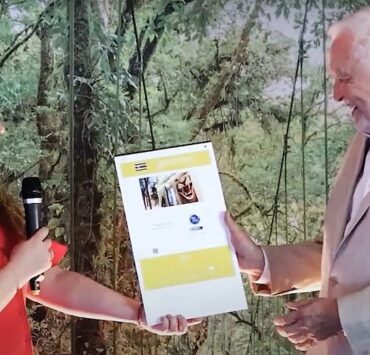CIRCULAR ECONOMY SHOULD BE A WAY OF LIFE

Prof. K.R. Chari is a multi-faceted management guru and academic.…
The concept of circular economy is no longer a topic merely of academic interest. At a time when climate change is affecting the entire globe and almost everybody, it isn’t a problem that governments alone can tackle. Along with our governments, we all have taken a lot from this earth, consumed in large quantities, and most importantly, generated a lot of waste too. There is, in fact, no other way now but to make circular economy a way of life.
Birla Institute of Management Technology (BIMTECH), established in the year 1988 in Greater Noida in Uttar Pradesh, provides management education. While this is their primary area of focus, BIMTECH too has concerns for the environment and the challenges of global warming. The institute has been initiating actions to reduce carbon footprint through various energy efficiency measures.
BIMTECH developed its own unique ecosystem to undertake innovative projects in the area of waste recycling from the point of view of fostering a circular economy. In the year 2009, the institute identified a team of faculty members headed by Prof. K. R. Chari to take up demonstrable projects in this area. The institute aimed at approaching the problem scientifically, but also was keen on developing workable solutions that can be implemented with tangible benefits. To start with, the team firmly believed that every waste has some kind of underlying value and that it can be converted into a useful material. This certainly required an out of the box thinking and an innovative approach.
Aligning with Sustainable Development Goals:
The first step was to align the team’s work with certain Sustainable Development Goals (SDG) propounded by the United Nations with the idea of ending poverty, protecting the planet, and ensuring that all people enjoy peace and prosperity. The BIMTECH team specifically targeted the following eight SDGs: Good Health and Well-being (SDG 3), Quality Education (SDG 4), Clean Water and Sanitation (SDG 6), Affordable and Clean Energy (SDG 7), Decent Work and Economic Growth (SDG 8), Industry, Innovation and Infrastructure (SDG 9), Responsible Consumption and Production (SDG 12), and Partnerships to achieve the SDGs (SDG 17).
The team concentrated on bulk industrial wastes, which do not have any proven or demonstrated recycling effort, with the basic belief that, in nature, there is nothing called waste, and that everything can be used for some purpose. The only problem is that people tend to look at the negative aspects first and very rarely consider the strengths of different bulk wastes. Most often, the industries generating these wastes spend a considerable amount of money in disposing of them, thereby adding to the costs of production. Such wastes are often dumped somewhere causing major environmental problems and health hazards.
From a scientific approach, the team started characterizing the wastes through physical and chemical analyses, to understand their composition and physical characteristics, so that appropriate use of the same can be identified. This was possible only through their acquaintance and good relationship with industry owners, and using the industry laboratories and facilities for experimentations and development of products that are technically feasible and commercially viable. Often, the exercise culminated in preparing techno-economic feasibility reports that the industry can readily use. Some key elements in the process were the following:
- Critical thinking and analysis: What, Why, When, Where, Who and How
- Not the Cost and Price, but creating Value
- Creativity and generation of alternative solutions and ideation
- Prototype development and testing
- Energy management principles, energy conservation, waste heat recovery, demand-side management, green energy forms like solar, tidal, wind, and fuel switching
- Waste characterization and recycling
The most prominent works and achievements of the team are:
1. Prepared a “Compendium of Recycling and Destruction Technologies for Waste Oils” for the UNEP, and is available on the UNEP.org website.1 The compendium overviewed the state of oil usage and waste oil management in selected countries. It provides a guide for assessing appropriate technologies closely connected with local community needs.
2. Waste Agricultural Biomass to Energy: A demonstration project for use of Waste Agricultural Biomass as a source of Energy.2 This project was implemented in India to promote the conversion of waste agricultural biomass into energy. Several capacity-building and awareness-raising workshops were carried out covering topics such as assessment of waste agricultural biomass, technologies, methodology for sustainability assessment of technologies, and policies.
3. Cupola furnace slag: With an estimated one million tons of annual generation of cupola furnace slag, the BIMTECH team demonstrated the first-time use of Cupola furnace slag for making pavement bricks in 2011. With the support and association of the Government of India, 45 units have already started using the waste for fruitful purposes.3
4. Rice Husk Ash: Being a major producer of paddy, India generates an estimated 5.5 million tons/year of rice husk ash. The team demonstrated the use of rice husk ash as a substitute for natural river bed sand for the construction industry and subsequently in many places.4

This helps in the conservation of natural resources and aquatic life. They also produced 96% purity Amorphous Reactive Silica with a Blaine number of about 3600, which is even finer than ash. This can be used for high-end products like silica crucibles.
5. Dust from Marble slabs industry: India produces an estimated 5 million tons of marble stone dust per year. This creates an environmental and health hazard. In close collaboration with the CSIR laboratory (CGCRI), Khurja, the team developed flooring tiles and building blocks from waste marble dust of Rajasthan and various other stone dusts in various regions of India.
6. Annual Environmental hazard in Delhi: Due to sheer economic advantage, the farmers in the three adjoining states of Delhi viz: Haryana, Punjab, and Uttar Pradesh, have adopted a practice of burning agricultural residue in fields. This has become an annual recurring problem for Delhi, which sometimes leads to even zero visibility due to environmental pollution. The BIMTECH team had conceptualized the economic use of such residue by demonstrating smokeless burning of agricultural residue. This has multiple advantages like, (a) it is free fuel for the farmers, (b) it substitutes coal/firewood/natural gas or LPG, and (c) it reduces deforestation and most importantly eliminates pollution hazards.5
7. Activated Carbon from spent coffee powder: The team developed activated carbon from spent/waste coffee powder. Samples were made and tested by M/s Activated Carbon India (P) Ltd., Hyderabad, Andhra Pradesh.
8. Heat insulation blocks from stone dust: After a chemical analysis of the dust, our team found that it contains high degree of Silica. Tried and tested blocks from the stone dust and demonstrated that they can be used as heat insulation blocks for industrial furnaces.
At the same time, BIMTECH faculty have been participating in various national and international conferences and presenting papers on green technologies, agricultural waste to energy, green energy, sustainable development, clean production, and waste recycling, to name a few. At the invitation of UNEP, I had the privilege to participate in sustainability seminars in Cambodia, Costa Rica, Brazil, and Japan.
BIMTECH’s concerted efforts have paid off in being recognized for its contributions towards fostering sustainability. The Federation of Indian Chambers of Commerce and Industry (FICCI) has conferred the India Circular Economy Award 2021 (not-for-profit category) to BIMTECH.
About the author: Prof. K.R. Chari is a multi-faceted management guru and academic. He is a recipient of the ‘National Productivity Champion-2021 for India’ award instituted by the Asian Productivity Origination (APO), Tokyo. His long career included positions such as Regional Director of the National Productivity Council of India, Professor in Operations Management, and finally as the Dean-Student Welfare at the Birla Institute of Management Technology (BIMTECH) at NOIDA. He has provided expert services to hundreds of organizations and has trained thousands of professionals over the past five decades. Know more about him by clicking on the author link.
(Notes: The views expressed in this article are solely the author’s and do not necessarily represent that of any organisation. Unless specifically mentioned, images are as provided by the author)
[2] https://www.jstage.jst.go.jp/article/jie/94/10/94_1129/_pdf
[3] Please see a related video produced by Foundation for MSME Clusters: https://www.youtube.com/watch?v=H-WpVObltfM&t=315s
[4] https://www.youtube.com/watch?v=W0t_KV8rAZU&t=125s
[5] Read more at: https://tennews.in/perfectly-smokeless-burning-of-agri-residue/
What's Your Reaction?
Prof. K.R. Chari is a multi-faceted management guru and academic. He is a recipient of the ‘National Productivity Champion-2021 for India’ award instituted by the Asian Productivity Origination (APO), Tokyo.
Prof. Chari worked with the National Productivity Council of India in various capacities, starting as an Industrial Engineer, and rising to the level of a Regional Director. In 2009, he joined academics as a Professor of Operations Management at the Birla Institute of Management Technology (BIMTECH), Greater Noida, India, and left the institution in 2021 while functioning as the Dean of student welfare.
He has provided expert services to hundreds of organizations and has trained thousands of professionals over the past five decades. His services in the industrial sector in India have helped a large number of organizations in enhancing productivity. Prof. Chari’s name is closely associated with the Value Engineering efforts across the country. He has done assignments for the United Nations Environment Program, including the preparation of a ‘Compendium of Recycling and Destruction Technologies for Waste Oils’. The compendium overviewed the state of oil usage and waste oil management in selected countries. It provides a guide for assessing appropriate technologies closely connected with local community needs.
During his stay in NPC and BIMTECH, he has made significant contributions in the area of waste recycling and circular economy, and worked passionately in bulk industrial waste recycling. He has been instrumental in developing innovative applications for various bulk wastes such as rice husk ash, waste oils and lubricants, marble dust and waste agricultural biomass.


